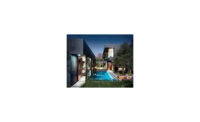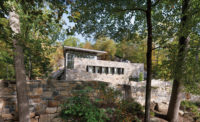Record Houses 2009
Villa 1 ![]() Vienna Way Residence
Vienna Way Residence ![]() House for a Photographer II
House for a Photographer II ![]() Dutchess County Guest House
Dutchess County Guest House ![]() Brick-Weave House
Brick-Weave House ![]() Upstate New York House
Upstate New York House ![]() N House
N House ![]() YTL Residence
YTL Residence ![]() Desert City House
Desert City House![]() House Ijburg
House Ijburg![]() House in Carapicuiba
House in Carapicuiba![]() House in Garrison
House in Garrison![]() House on TownLine Road
House on TownLine Road ![]() Pencalenick House
Pencalenick House ![]() Ventana Canyon House
Ventana Canyon House
Agence Jouin Manku
Kuala Lumpur, Malaysia
Is this the moment to build a 32,292-square-foot private house? In all fairness, the house in Kuala Lumpur, which was completed in 2008 after five years of design and construction, was born of headier times. The client, Yeoh Seok Hong, wanted to accommodate three generations of his Chinese-Malaysian family, which numbers eleven persons, in a house also designed for business entertaining. It is named the YTL Residence for the client’s father, 80-year-old Yeoh Tiong Lay, founder of the YTL Group, a company that specializes in the management of regulated utilities and infrastructural construction projects.
The YTL Residence is located in the residential Daramsara area of the Malaysian capital, where it occupies 95 percent of a hilltop site with a view of the city center and Cesar Pelli’s 88-story Petronas Towers (1998). Unusual in both size and form, the house marks a significant feat of collaboration that encompasses architecture, engineering, interior design, and landscaping.
The client knew of the French designer Patrick Jouin from stays at the Plaza Athenée Hotel in Paris, where he and his father admired Jouin’s interiors for the restaurant and bar. Jouin, formerly a designer with Philippe Starck’s Paris studio, and his recent partner, Sanjit Manku, a Canadian-trained architect who had previously worked for Yabu Pushelberg, hoped the family would share their commitment to Modern architecture, since Daramsara is filled with all sorts of “neo”-style architecture from around the world. They found Yeoh and his wife Kathleen were not only keen on having a Modern house, but desired a spectacular one that would demonstrate the construction know-how of the YTL companies. Even though Jouin and Manku had not designed a house before, the Yeohs were not worried: The head of architecture for the construction arm of the YTL Group, Baldip Singh, and the chief of its civil engineering department, Lee Hang Meng, would be playing key roles in building the house. Yeoh himself is an engineer who remained closely involved with the structural aspects of the project.
Unlike many Asian cities, Kuala Lumpur still has a great deal of tropical vegetation, which landscape designer Sophie Agate Ambroise and her firm, Officina del Paesaggio, carefully studied—planting both the exterior band of land that surrounds the high walls of the house, the lush inner courtyard at the street level, and the upper gardens near the swimming pool. Jouin and Manku designed the residence so that the more public spaces for guests—a ballroom, a formal dining room that seats 30 people, a large parking garage, a wine cellar, and a chapel—are located on the lowest level, separated from the family spaces above. The main floor for the family itself contains a living room, dining room, and kitchen, but is certainly spacious enough to receive guests. It features a 16-foot-high ceiling and a glazed wall facing east toward downtown Kuala Lumpur. Many of the main level’s glass walls slide back to allow cool breezes to enter the interior, although air-conditioning in this hot climate is still necessary.
The two upper floors include a total of nine bedrooms, with one suite for Yeoh Tiong Lay and his wife and a double-height library, and a second suite for Yeoh Seok Hong and his wife, along with bedrooms for the family’s seven children.
In arriving at the design of this organically shaped house, Jouin states, “We were searching for a spatial and formal language as dramatic as the landscape itself. While we didn’t want to create a village house or a traditional tropical house, we thought it should be truly based in the particular spatial character of the natural environment.”
The structure, a hybrid of reinforced concrete, steel, and wood framing, was complicated by the biomorphic shape as well as the program. The lower level of the house is contained within a poured-in-place-concrete base on which the main level sits and the upper levels are balanced. Three concrete core units at particular points—the main entrance, the elevator core, and the kitchen—support the dramatically cantilevered upper volume containing the two bedroom levels. Jouin conceived the body of the house “as a carapace that protects the private spaces.” A metallic skin wraps around the cantilevered form in a way that gives the house something of an alien presence in the midst of the much less inventive architecture of the neighborhood. Jouin explains, “My work often has a sensual shell, with a good deal of attention focused on the skin.”
Because of the landscaping, the house blends into its natural setting in spite of occupying a vast proportion of the site, which is about 1 acre in size. As the visitor ascends from the automobile entrance at street to the living and family dining area a floor above, he or she has the impression of being simultaneously outside and inside the house. The integration with the outdoors recalls the work of Frank Lloyd Wright, yet at the same time its openness and its elevation off the ground relates it to certain traditional Malaysian architecture. It is an original attempt to define a new residential architecture for a tropical climate, if at a scale few may find feasible to emulate.

















Post a comment to this article
Report Abusive Comment